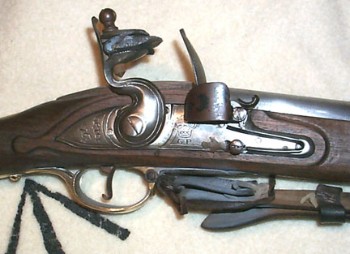
The flintlock was the dominant form of firing method for personal arms for over 200 years from the early 17th century to the early 19th century. It was simpler than the wheel lock it replaced, it produced a spark more reliably, and was easier to make. While the basic principle remained the same, the design developed significantly over the two hundred years. Indeed the early percussion cap guns used the flinlock striking mechanism, merely replacing the frizzen and pan with a cap mount and the flint with a hammer.
The most important innovations are credited to the French gunmaker Marin Le Bourgeoys. He replaced the separate steel and manually operated pan cover with the spring-loaded frizzen. He also introduced an intermediate position between the released and full cock positions (known as the half cock position) in which the flint was held away from the frizzen, but the trigger could not release the cock (i. e. the gun could not fire).
Gunmakers of the time were continually experimenting with the flintlock, adding a bit here, cutting back there, aiming to make the gun faster, more reliable and weather proof. Some of the variations involve which side of the lockplate parts are mounted. Some (particularly on expensive guns) involve sophisticated techniques to reduce friction. I will limit myself to the form as used in both the Tower musket and the Baker rifle. These use the same basic set of parts, mounted in essentially the same way, the main difference being in shape.

The picture on the left shows the lockplate area of an original Baker rifle of the common "flat" type. The image on the right shows the lockplate area of a replica Brown Bess musket, with additional safety features for use in modern re-enactments: a flash guard on the pan and a frizzen stall.
This is the plate upon which the lock mechanism was constructed before being attached to the gun. It usually incorporated the priming pan. The rear end of the priming pan extended into a flange which contained the outer pivot hole for the frizzen. The inner pivot hole was in the main plate. In most guns the lockplate was fitted on the right hand side of the stock against the barrel, with the priming pan alongside the touchhole on the side of the barrel. All the following diagrams assume a viewpoint looking at the lockplate from the outside with the gun pointing to the right.

There was some regional variation as to which side of the lockplate parts were mounted. Both the Tower (Brown Bess) musket and the Baker Rifle followed the common English pattern of the time in which the following parts were mounted outside the lockplate:
The CockThe cock is a rotating arm with the flint jaws on the outer end and a square hole at the pivot point. The rear of the flint was wrapped in a piece of leather (for grip) and clamped between the two jaws by tightening the screw. The traditional English style of cock had a graceful S-shaped arm. |
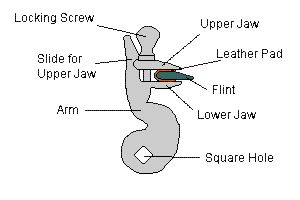 |
The FrizzenThe frizzen is a combination steel (or striking plate) and priming pan cover. It is pivotted about a point in front of the priming pan on a shaft which passes through the lock plate. A cam extends down below the pivot point and a stop extends forwards from it. Pressure on the cam from the frizzen spring holds the frizzen in one of two positions: closed with the pan cover pressed over the pan; or open with the stop pressing against the frizzen spring. |
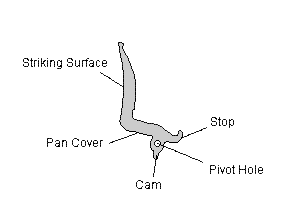 |
The Frizzen SpringThe frizzen spring is a V-shaped spring which acts on the cam of the frizzen to hold it either closed (with the cover over the pan) or open (with the stop resting against the spring). |
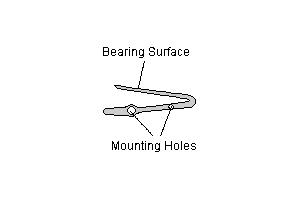 |
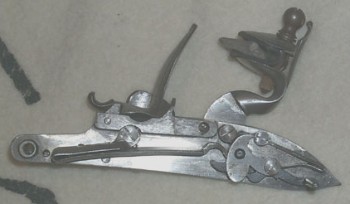
The images above show the locks of a replica Baker rifle and a replica Brown Bess musket from the inside. Both are in the half cock position and you can see the knife edge of the sear sitting well in the deep notch (or dog) of the tumbler. The parts mounted inside the lockplate are:
The TumblerThe tumbler has a shaft ending in a square spigot which passes through the lock plate to engage in the square hole in the cock so the cock and tumbler rotate together. The front of the tumbler extends forward in an upward curve, the heel, to provide a bearing surface for the main spring. The lower edge of the tumbler has three notches or dogs cut in it. The front is a deep one to prevent the tumbler rotating too far in the "fired" position and disengaging from the mainspring. The middle is also a deep one and provides the "half-cock" position. The rear is a shallow one at the "full-cock" position. |
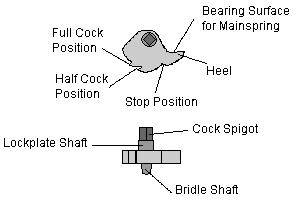 |
The MainspringThe mainspring is a strong, V-shaped spring with a hooked end so that only the tip of the spring bears on the tumbler, reducing friction and increasing the speed of the action. The mainspring exerts a downward force on the heel, causing the cock to rotate rapidly towards the frizzen, unless the knife edge of the sear is engaged in one of the dogs in the lower edge of the tumbler. |
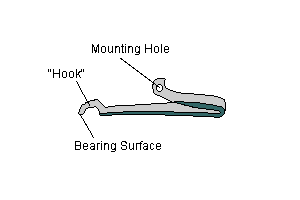 |
The Sear (or scear)The sear is a spring-loaded pawl which has a knife edge at the front to catch the notches in the tumbler. At the rear there is a bar which extends inwards (i. e. at right angles to the pawl). The trigger can operate against this bar in the full-cock position to withdraw the sear and disengage the tumbler. |
 |
The Sear SpringThe sear spring is a light, V-shaped spring which presses downwards on the back of the sear (behind the pivot point) pushing the front section of the sear up against the tumbler. Pressure of the trigger on the rear bar of the sear compresses this spring and disengages (or attempts to disengage) the sear from the tumbler. |
 |
The BridleThe bridle is a flat piece of metal which holds the tumbler and sear in place.It provides the inner pivot holes for the sear and tumbler. A guard section also ensures that the sear cannot slip from under the tumbler. |
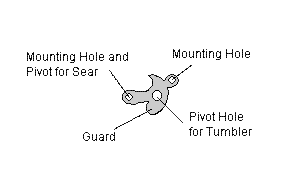 |
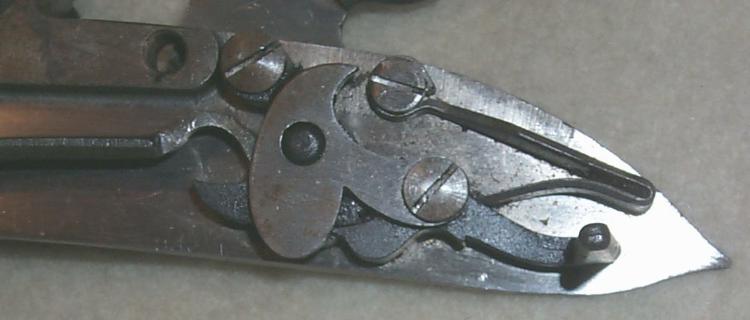
The image above is a close up view of the lock of the replica Brown Bess musket viewed from the inner side. The bridle dominates, holding the tumbler and sear in position. The end of the mainspring can be seen, pressing on the heel of the tumbler. The lock is in the half cock positon, and the knife edge can be clearly seen nestled in the deep notch. The cutaway notch of the full cock postion can be seen to the right of it.
Not mounted on the lockplate, but part of the action is:
| Mounted in the stock, the trigger has a downward extending lever for the finger to push, and a backward extending arm to engage with the bar on the sear. A spring holds the trigger in the disengaged position. |  |
Thanks to Alan for his suggestions in writing this section and to Mike and Dan for the superb photographs. The diagrams were derived from photographs in the books of Frederick Wilkinson.
Return to Random Shots
Return to Main Page
Content Copyright © 2000, 2001, 2002, 2003 Susan H Law and her licensors. All rights reserved.
Last update 11/3/03